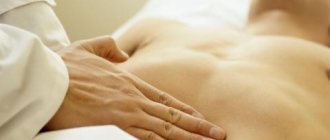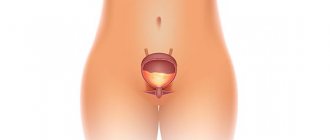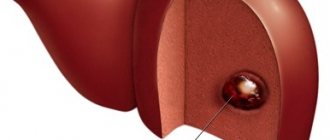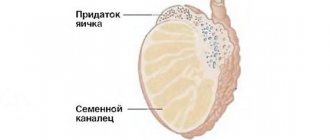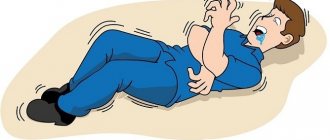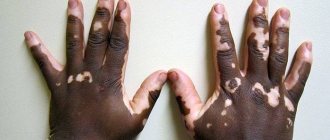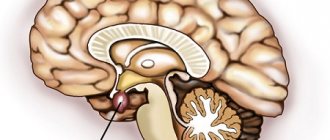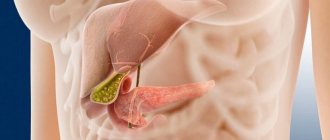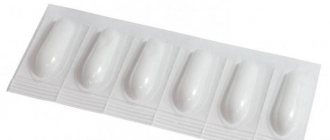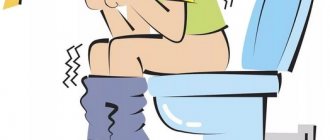The gallbladder is a sac-shaped organ with a hollow structure. Its main role is the accumulation of bile and its systematic release into the duodenum for digestion of food. The gallbladder consists of a body, a fundus, a neck with an outlet and has the property of changing shape depending on the degree of bile filling. If the constituent elements of an organ are deformed, the entire digestive tract suffers. Gallbladder deformity is most often diagnosed in adulthood, after 45–50 years. Often, pathology develops in the fetus during the prenatal period.
Types of curvature of the gallbladder
Doctors distinguish 3 sections of the gallbladder: neck, fundus and body. Most often, the shape of the gallbladder changes in the area between the body and the bottom. The bend of the organ is accompanied by nausea, excessive sweating, pain on the right under the ribs, which radiates to the shoulder blade and ribs. Patients' complexion changes and they lose weight quickly. It is important to provide timely assistance to the patient, otherwise the likelihood of dangerous complications increases.
Most often, deformation of the gallbladder is observed in the area between its body and the bottom.
Repeated persistent deformation of an organ in several areas at once is observed a little less frequently. As a result of the curvature, the size of the bladder increases, calculous cholecystitis is formed, adhesions are formed, and hepatic circulation is disrupted. The patient suffers from dyspepsia and pain.
Labile deformity most often occurs due to intense physical activity. In this case, the disease is asymptomatic and goes away without treatment after a certain time.
Many patients are diagnosed with deformation of the gallbladder neck, which is provoked by chronic cholecystitis (inflammatory damage to the walls of the gallbladder). Inflammation affects the outer walls of the organ, adhesions form, and as a result, the organ becomes deformed. An anomaly in the shape of the gallbladder is manifested by digestive disorders and changes in the composition of bile.
Sometimes the bend in the neck is so serious that the bubble is completely twisted around its axis. There are several reasons for the occurrence of this pathology: prolonged physical overload, lengthening of the neck of the organ or its sagging.
JP often develops against the background of cholecystitis and cholelithiasis. The abnormal form occurs due to sclerotic changes in the walls of the bladder or due to adhesions in the bottom of the organ. Wall compaction and curvature can be detected using ultrasound.
Contour deformation is characterized by a change in the outline of an organ. Normally, the bladder resembles a pear connected to the liver at the bottom. When the disease occurs, the contours of the gallbladder change in one direction or another. The irregular form occurs due to chronic cholecystitis or impaired bile excretion. Then patients suffer from pain, especially after eating, stress or physical overload.
The S-shaped deformation is characterized by a double inflection of the bubble. Most often these are congenital pathologies that are transmitted from parents to child. There is an acquired S-deformity, when the development of the gallbladder outstrips the growth of surrounding organs.
Forms of pathology and causes of development
Gallbladder deformity can appear in several varieties:
- S-shaped deformation - a curved organ or septum, in appearance the gallstone looks like a bull's horn or hook, the walls are S-shaped; the pathology is mainly of congenital origin;
- repeated disruption of the shape of the bladder in several places - a severe type of deformation that occurs with active inflammatory changes, swelling of the organ and dyspeptic symptoms;
- violation of the shape of the cervix is typical for persons with long-term chronic cholecystitis;
- violation of the shape of the body of the gallbladder - a form of pathology characterized by a mainly asymptomatic course, detected by chance; but with errors in nutrition it can lead to gastrointestinal motility disorders;
- labile deformation due to physical activity is a temporary condition and is not considered a pathology;
- contour deformation with a change in the outlines (contours) of an organ develops as a result of chronic catarrhal processes or difficult excretion of bile, a typical symptom is severe pain after eating or lifting heavy objects;
- complete absence of an organ (agenesis) or its duplication;
- diverticulosis - the presence of single or multiple protrusions in the walls of the gallbladder;
- abnormal location - intrahepatic, with a changed direction of the long axis.
According to the mechanism of occurrence, deformity of the gallbladder is divided into congenital and acquired. Congenital deformity develops due to disruptions in the process of intrauterine embryo formation. An abnormal form of gall bladder at the genetic level can be provoked by:
- burdened heredity;
- incorrect lifestyle of the expectant mother - drinking alcohol and nicotine;
- bacterial infections suffered during pregnancy and exacerbations of chronic pathologies.
The abnormal structure of the gallbladder is formed in the embryo before the 12th week of pregnancy, when the digestive tract is formed. Acquired deformity in children develops against the background of inflammatory diseases of the gastrointestinal tract - biliary dyskinesia, calculous formations in the biliary cavity.
Causes of gallbladder deformation in adults:
- calculous cholecystitis;
- Botkin's disease;
- adhesions in the peritoneal cavity;
- prolapse of neighboring organs;
- diaphragm weakness;
- hernia of the anterior peritoneal wall;
- previous operations on the gastrointestinal tract and peritoneum;
- poor nutrition, including improper “eating” behavior - alternating strict diets with periods of overeating;
- tumor processes;
- parasitic infections.
In women, gall bladder deformity often develops during pregnancy. The growing uterus and embryo put pressure on nearby organs and deform them. A similar process occurs in the presence of overweight and obesity - under the weight of fat masses, organs located in the peritoneal cavity, including the gallbladder, shift and change shape.
Causes of the disease
There are many factors that provoke deformation of the gallbladder and other diseases of the biliary tract. Some of them develop during fetal development, while others develop later.
Often the gallbladder becomes deformed due to the formation of stones in its cavity or in the bile ducts
A hereditary factor often provokes JP even before birth. The pathology is transmitted from parents to child. The disease occurs due to disruption of intrauterine development of the fetus. This happens when the expectant mother smokes, drinks alcohol or is physically overexerted.
The following causes of JP are distinguished:
- Chronic inflammation of the bile ducts.
- Formation of stones in the gallbladder or ducts.
- Poor nutrition, when strict diets alternate with overeating.
- Excessive strain on the abdominal muscles.
- Adhesive process. This means that adhesions form in the gallbladder.
- Diseases of the digestive organs.
- Impaired contraction of the gallbladder and its ducts.
- Tumors in the gallbladder.
In addition, elderly patients often suffer from VSD due to prolapse of internal organs. Often the shape of the gallbladder changes due to a hernia of the abdominal wall or after surgery on the abdominal organs.
The essence of the problem
Deformation of the gallbladder is a fairly common pathological condition in which there is a change in the structure, contours and volume of this organ. Despite the fact that such changes are not considered an independent disease, they can significantly affect a person’s quality of life.
For patients with such a deviation from the norm, it is advisable to adhere to the rules of a healthy diet, dose physical activity, and also maintain a work and rest schedule.
The reassuring fact is that in most cases the presence of pathology does not manifest itself in any way. People sometimes accidentally find out about existing abnormalities during examination for other health problems.
But often deformation of the bladder leads to a whole chain of serious diseases of the liver, pancreas and gastrointestinal tract.
That is why, if defects in the structure of the gallbladder are detected, you should follow the recommendations of specialists and keep the condition of the organ under control.
Symptoms
Symptoms of JP depend on how quickly the process develops. With a sharp deformation, pain in the area of the gallbladder and liver intensifies. In addition, the patient experiences jaundice of the skin and internal membranes, nausea, and aversion to food. Sometimes body temperature rises. When intense pressure is applied to the affected area, severe pain occurs and the tongue is covered with a dense yellow coating.
With a sharp curvature, pain occurs in the area of the gallbladder and liver
With gradual curvature, symptoms appear when the capacity of the bile duct is disrupted due to a violation of the shape of the organ. Then the following signs of gallbladder deformation appear:
- Decreased appetite.
- Discoloration of feces.
- Fatty elements are present in the stool.
- The patient is losing weight slowly.
In addition, the likelihood of discomfort and heaviness in the area where the deformed bladder is located increases. Some patients experience acute pain in the intestines, dyspepsia (bloating, nausea, vomiting, defecation disorders).
Necrosis of the cervical organ is the greatest danger. Due to prolonged curvature, the gallbladder tissue dies, and bile penetrates into the abdominal cavity. With this complication, the risk of peritonitis (inflammation of the peritoneum) and even death of the patient increases.
Clinical manifestations
In most cases, symptoms of shape distortion are mild or not observed at all. That is why changes in the contours of an organ are detected by chance. But it is possible that symptoms such as:
- feeling of heaviness in the stomach;
- bitterness in the mouth;
- white coating on the tongue;
- nausea, vomiting;
- loss of appetite;
- fatty stools;
- stool lightening;
- pain in the right hypochondrium, radiating under the scapula and into the collarbone;
- flatulence.
A laboratory blood test reveals elevated bilirubin levels.
Instrumental examination
The appearance of the above symptoms becomes an indication for a more thorough examination. To do this, it is recommended to undergo an ultrasound, with the help of which the condition of the organ is clarified.
Ultrasound examination helps to identify the presence of deformation changes. There are certain echo signs. From them, the doctor can draw conclusions about the presence and type of pathology .
Sonographic signs make it possible to diagnose the following organ anomalies:
- twisting;
- constriction;
- doubling the bubble shares;
- distortion of shapes and sizes;
- atypical localization of the organ.
Echoscopically it is possible to detect not only the deformation of the gallbladder, but also the presence of inflammation in it, the formation of stones, as well as tumor neoplasms.
JP in adult patients
Curvature of the gallbladder can manifest itself as a result of cholecystitis, hepatitis A. If an adult patient is diagnosed with “deformation of the gallbladder,” then the pathology may well be congenital; he simply had no symptoms and had not previously diagnosed the biliary tract.
In adults, JP can occur due to cholecystitis or hepatitis A
JP in adults may have subtle symptoms, be discovered by chance, or manifest standard signs:
- Nausea, vomiting.
- Pain in the epigastrium and under the ribs on the right.
- Increased gas formation in the intestines.
- Excessive sweating.
- Difficult or frequent bowel movements.
Difficult or delayed bowel movements often indicate inflammation in the gallbladder or stones in the organ. If such symptoms occur, you should visit a gastroenetrologist or hepatologist. The doctor will conduct an examination, establish an accurate diagnosis and prescribe competent treatment. With asymptomatic flexion of the gallbladder, the patient should periodically undergo preventive ultrasound.
Lifestyle
If you have been diagnosed with “acquired deformity of the gallbladder,” then it’s time to completely change your life and give up old habits.
Do exercises every morning. You can also devote some time to athletics, but if you do not have such an opportunity, you can do without it.
Follow your diet. It is most important. Otherwise, stagnation of bile may occur, which leads to dire consequences. Do not drink alcoholic beverages under any circumstances, even on holidays.
Don't smoke and try to be less likely to go where people smoke. Tobacco causes increased bile production.
If you are offered surgery to remove your gallbladder, do not refuse. Tens of thousands of people have had it and feel much better than before.
Curvature of the gallbladder in children
Deformation of the gallbladder in a child is a common phenomenon, especially among adolescents. Prolonged stagnation and active growth of the body provoke an inflammatory reaction. The trigger for curvature of the gallbladder is biliary dyskinesia (biliary dyskinesia) or the formation of stones in the biliary system.
JP in children occurs due to inflammation of the gastrointestinal tract or diseases of the biliary system
If we exclude congenital pathology, then CVD in children occurs for the following reasons:
- Inflammation of the digestive organs.
- Diseases of the biliary system.
- Stagnation or impaired excretion of bile secretions.
The disease in patients of the younger age category is manifested by a dull pain on the right under the ribs, decreased appetite, bitterness in the mouth, periodic belching with an unpleasant odor, and nausea. Pain occurs after eating fatty, spicy foods. Pain syndrome is also a consequence of overeating or excessive physical activity.
The disease in the acute phase is accompanied by joint pain, weakness, fever, change in skin color, and headache. If such symptoms occur in a child, you should consult a doctor.
Congenital organ deformation is diagnosed in newborns. In this case, the pathology is transmitted from close relatives (mother, father, sibling).
In addition, JP may occur for the following reasons:
- Taking prohibited medications by the expectant mother.
- Active or passive smoking.
- Diseases (especially chronic) of women during pregnancy.
- Drinking alcohol during pregnancy.
The highest danger to the fetus exists before the 13th week of pregnancy, when the digestive organs are formed. From the second trimester, the risk of gallbladder curvature decreases.
The course of pathology in childhood
The gallbladder in children often becomes deformed at the age of 12–15 years as a complication of sluggish inflammatory processes in the digestive tract, or against the background of prolonged stagnation of bile. An important role in the formation of pathology belongs to poor nutrition with an abundance of fast food and sweet carbonated drinks.
Deformation of the gallbladder in a child is manifested by alarming symptoms:
- constant dull pain in the right side;
- constipation that is difficult to treat;
- feeling of heaviness in the stomach;
- occasional vomiting;
- decreased appetite;
- belching air with the smell of rotten eggs.
In the acute period, the child experiences severe pain in the right side, signs of intoxication develop - the skin turns pale, acquiring a gray tint; weakness increases. Fever and severe headaches may occur. The listed symptoms require urgent medical attention.
When the gallbladder is deformed, newborns and infants experience poor night sleep, anxiety during feeding, and severe bloating. Sometimes signs of jaundice appear. Breasts with deformed gall bladder almost always gain weight poorly due to inadequate absorption of nutrients.
Consequences of the disease
Complications of DP depend on how much the change in its shape affects the functionality of the organ. If the outflow of bile is disrupted due to pathology, then the likelihood of bile stagnation increases. As a result, an inflammatory process may occur followed by the formation of stones.
When the gallbladder is deformed, the likelihood of developing peritonitis increases
Due to the deformation, there is a risk of long-term disruption of blood flow in the biliary system. Over time, the likelihood of necrosis of the gallbladder tissue, rupture of its walls and leakage of bile into the abdominal space increases. As a result, peritonitis develops, which is accompanied by general poisoning and disruption of the functionality of all organs and systems. If the organ is deformed and the patient develops peritonitis, then he needs urgent help. Otherwise, the likelihood of death increases.
The consequences of deformation are not always so dangerous. With labile curvature, there is no need for treatment, since the pathology goes away on its own. A similar scenario is possible with congenital deformation, when the child simply outgrows the anomaly and at the next ultrasound the organ again has a normal shape.
Regardless of the type of deformation, the patient’s condition must be constantly monitored, otherwise the process may worsen.
Possible complications
The consequences of deformation can be chronic, some of them seriously worsen the general condition of the patient. Among the complications, the following are considered especially dangerous:
- prolonged stagnation of bile, which over time can provoke the formation of stones;
- esophagitis;
- chronic intestinal inflammation;
- decreased immunity;
- peritonitis is one of the most dangerous consequences, fraught with death, due to the fact that the walls of the bladder are depleted, bile spreads throughout the abdominal cavity.
Labile deformity associated with excessive physical activity usually does not cause complications. They can arise only when the pathology takes on a permanent form.
Ultrasonography
Ultrasound is the most popular and informative method for diagnosing abdominal organs. This method allows you to identify deformation of the gallbladder and quickly determine treatment tactics. Ultrasound examinations are safe for pregnant women and children.
Ultrasound of the gallbladder is performed from different angles
With the help of ultrasound, the curvature of the organ can be viewed from different angles. For example, often the bends of the bladder are not constant and disappear if the patient stands or strains his stomach during the examination. In other cases, such actions, on the contrary, can provoke bends. That is why ultrasound examination is performed in different positions.
The biliary organs are examined if there is a suspicion of inflammation, the formation of stones, the development of a neoplasm, or jaundice of unknown origin.
During diagnosis, signs are of great importance. The doctor pays attention to the position of the organ, its shape, dimensions, movement during breathing, internal and external contours, density and structure of the walls, etc.
Normally, the gallbladder appears as an echo-negative formation, which is located on the posterior surface of the right lobe of the liver. Its bottom protrudes from the lower part of the liver by 10 - 15 mm. The length of the organ is from 70 to 100 mm, the width is from 3 to 40 mm.
When inflamed, its walls become denser, thicker, and the echostructure increases. The following echo signs appear: bending, retraction of the walls, disruption of the shape and contours of the bladder. If there are stones in the organ cavity, the echo signal from the area where the deposit is located increases.
Diagnostics
The main method for diagnosing deformity is ultrasound of the gallbladder. This is a simple technique that is suitable for all people. To make an accurate diagnosis, the organ is examined in various projections.
A healthy gallbladder is an echo-negative formation that has no internal structures and is localized in the upper abdomen on the right. The disease is indicated by certain echographic signs. One of them is a change in the structure of the organ (manifested in the form of echo-positive structures).
Ultrasound helps diagnose hardening of the walls of the affected organ.
Characteristic of various forms of cholecystitis. If anomalies are detected in the structure of an organ, a study of its functioning is carried out. For this purpose, dynamic cholecystography is performed.
Treatment methods
Congenital curvature of the organ, which is not accompanied by unpleasant symptoms, does not require special therapy. Treatment for gallbladder deformity is necessary when the patient experiences discomfort and pain. To completely eliminate the defect, 3–4 courses are prescribed from 10 days to 2 weeks. It is necessary to restore the functionality of the biliary system, relieve pain and inflammation.
With JP, the patient must take medications and follow a diet
Many patients are interested in the question of how to treat JP. To do this, you must follow the following rules:
- Maintain bed rest during the acute phase of the disease.
- Provide sufficient fluid volume.
- Follow a special diet.
- Take antispasmodics and analgesics. In the acute phase, Drotaverine, Baralgin, etc. are administered intramuscularly. In the presence of stones in the gall bladder or ducts, atropine sulfate is used; in more severe cases, Tramadol is used.
- The patient is prescribed antibiotics with a wide spectrum of activity along with antifungals and probiotics.
- In case of general poisoning, symptomatic treatment is carried out.
- Choleretic drugs are used after eliminating the symptoms of the acute phase: Gepabene, Flamin, Nicodin, Oxyphenamide, etc.
- Vitamin preparations are taken to strengthen the immune system. For this purpose, retinol, tocopherol, ascorbic acid, and B vitamins are used.
- When symptoms weaken or disappear, physiotherapy (electrophoresis) is carried out and herbal preparations are prescribed.
- Physical therapy and abdominal massage facilitate the outflow of bile secretions and reduce the likelihood of stone formation. During the treatment period, heavy physical work and sudden movements should be avoided, as such actions can provoke twisting of the bladder.
If you experience abdominal pain or a bitter taste, consult your doctor immediately.
When treating JP, you need to eat right
Diet for JP
During an exacerbation, the patient must follow a diet to reduce the load on the gallbladder. In this case, it is necessary to clearly separate permitted and prohibited foods, dishes, and drinks:
| Name of product or dish | Allowed | Forbidden |
| Flour products | Semi-dry baked goods made from rye flour, pasta. | Fresh pastries, fried dough, confectionery. |
| First meal | Soup puree of cereals, vegetables with the addition of yolks, herbs. | Soup with meat, mushrooms, fish, fried. |
| Cold dishes | Salad of vegetables, fruits, boiled diet sausage, low-fat cheeses. | Canned vegetables, spicy, fatty, smoked products. |
| Meat | Lean meat, steamed or boiled (stuffed cabbage rolls, meatballs). | Fatty meat, lard, offal. |
| Fish | Lean fish, baked or boiled. | Fatty fish, fried, smoked or marinated. |
| Eggs | Steamed egg white omelette. | Fried eggs, yolk. |
| Dairy products | Milk, kefir, sour cream, low-fat cottage cheese. | Fermented milk products with high fat content (from 2.5%), cream. |
| Vegetables | Almost all. | Sorrel, radishes, garlic, pickled vegetables. |
| Legumes | Green peas in puree form. | Beans, lentils, peas. |
| Fruits, berries | Not sour, fresh, boiled or baked, dried fruits. | Sour varieties of fruits and berries. |
| Sweet dishes | Jelly, soufflé, marmalade, marshmallows, etc. | Chocolate, cream, ice cream. |
| Oil | Butter (minimum amount), refined vegetable oils. | Solid fats of vegetable origin. |
| Beverages | Weak tea, coffee with milk, compote, juice from fruits and vegetables. | Cold, carbonated drinks, coffee (especially instant), cocoa. |
| Seasonings, sauces | Homemade sauces based on sour cream, milk, vegetable broth, fruit syrup. Greens, vanillin, cinnamon. | Store-bought mayonnaise, ketchup, hot seasonings. |
It is recommended to avoid sour foods, fried and spicy foods. It is better to eat fresh, boiled, steamed or baked foods. Spicy and hot food is strictly contraindicated; suitable temperature is from +15 to +60°. It is recommended to eat food in minimal doses 5 – 6 times per day. It is necessary to drink at least 2 liters of filtered water.
Based on all of the above, JP does not always require treatment, but it is necessary to constantly monitor the condition of the organ. Diet, moderate physical activity, and a calm moral state are mandatory points that can help you avoid unpleasant symptoms and dangerous consequences of this anomaly.
Nutritional Features
Deformation of the gallbladder is not one of those pathologies in which you should be on a strict diet for the rest of your days. Of course, during an exacerbation, dietary restrictions are necessary, and you yourself, tormented by nausea and pain in the right side, will not want to fill your stomach with heavy food. But during the period of remission, you can gradually include new dishes in your diet. Just carefully monitor your body’s reaction: if some dish causes you discomfort, it is better to give it up for a while.
What are the dietary principles that you need to follow?
First of all, this is a rejection of spicy and sour, fatty and sunflower oil fried in large quantities (deep-fried).
Food must be prepared correctly: boiled in water or steamed (during the period of remission - in chicken broth), stewed in its own juice or baked in foil or a special sleeve. By the way, a baking sleeve can easily replace a missing steamer - put the prepared products in it, tighten it tightly on both sides with the included wire fasteners, lower it into a pan of boiling water and set the timer - after the required period of time you will get a juicy, tender dish cooked to all tastes dietary rules.
Currently reading: Symptoms, consequences and treatment of a bend in the neck of the gallbladder
Eat small meals - five to seven times a day, in small portions. Tea or coffee with sandwiches and one very large meal are absolutely unacceptable!
Consume all foods and drinks slightly warmed. Eating food straight from the refrigerator (not to mention crunching on an icy sausage from the freezer) is just as unacceptable as swallowing a fire-breathing stew like a volcano without even removing the pan from the stove. The same applies to drinks: let the tea cool a little, and keep the juice, milk or water at room temperature.
Don't forget to drink a lot! An adult needs from 2 to 2.5 liters of water per day. It is water, not liquid!
Avoid eating foods that put excess strain on the gallbladder: thick soups with strong meat, bone, fish or mushroom broth, offal, animal fats, egg yolks and sauces made from them.
Do not overeat under any circumstances! By systematically overloading the gallbladder, you cause great harm to it! How to avoid this? Eat slowly, thoughtfully, chewing every bite thoroughly. Don't forget that the feeling of fullness does not come immediately. It will take about twenty minutes after you start your meal before you feel full. Imagine how many harmful, incompatible foods you will have time to swallow during this time if you are in a hurry!

